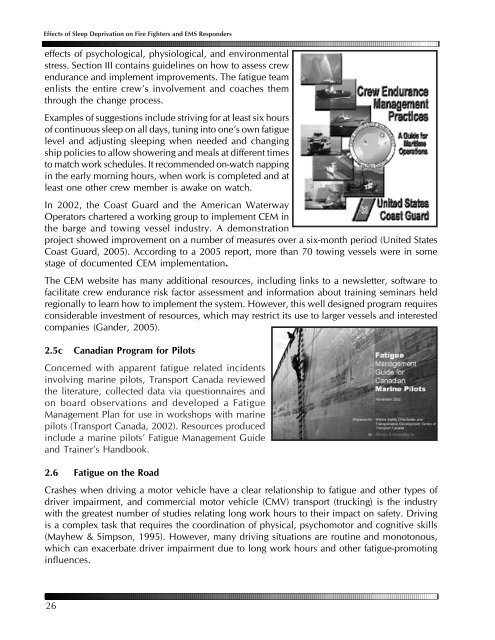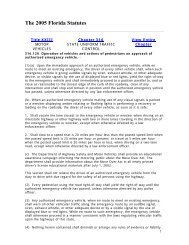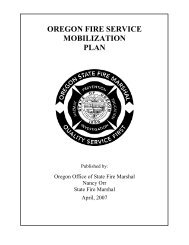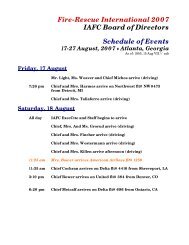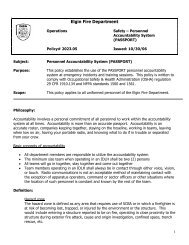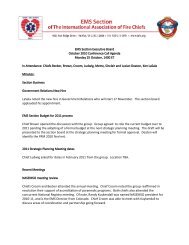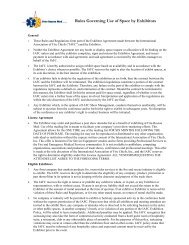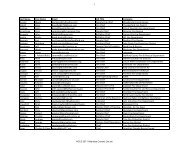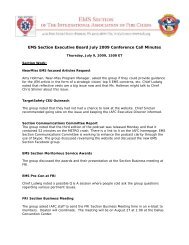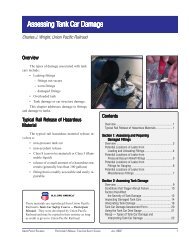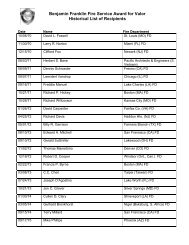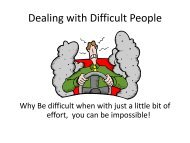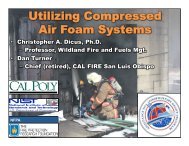Effects of Sleep Deprivation on Fire Fighters and EMS ... - NAEMT
Effects of Sleep Deprivation on Fire Fighters and EMS ... - NAEMT
Effects of Sleep Deprivation on Fire Fighters and EMS ... - NAEMT
You also want an ePaper? Increase the reach of your titles
YUMPU automatically turns print PDFs into web optimized ePapers that Google loves.
<str<strong>on</strong>g>Effects</str<strong>on</strong>g> <str<strong>on</strong>g>of</str<strong>on</strong>g> <str<strong>on</strong>g>Sleep</str<strong>on</strong>g> <str<strong>on</strong>g>Deprivati<strong>on</strong></str<strong>on</strong>g> <strong>on</strong> <strong>Fire</strong> <strong>Fighters</strong> <strong>and</strong> <strong>EMS</strong> Resp<strong>on</strong>ders<br />
effects <str<strong>on</strong>g>of</str<strong>on</strong>g> psychological, physiological, <strong>and</strong> envir<strong>on</strong>mental<br />
stress. Secti<strong>on</strong> III c<strong>on</strong>tains guidelines <strong>on</strong> how to assess crew<br />
endurance <strong>and</strong> implement improvements. The fatigue team<br />
enlists the entire crew’s involvement <strong>and</strong> coaches them<br />
through the change process.<br />
Examples <str<strong>on</strong>g>of</str<strong>on</strong>g> suggesti<strong>on</strong>s include striving for at least six hours<br />
<str<strong>on</strong>g>of</str<strong>on</strong>g> c<strong>on</strong>tinuous sleep <strong>on</strong> all days, tuning into <strong>on</strong>e’s own fatigue<br />
level <strong>and</strong> adjusting sleeping when needed <strong>and</strong> changing<br />
ship policies to allow showering <strong>and</strong> meals at different times<br />
to match work schedules. It recommended <strong>on</strong>-watch napping<br />
in the early morning hours, when work is completed <strong>and</strong> at<br />
least <strong>on</strong>e other crew member is awake <strong>on</strong> watch.<br />
In 2002, the Coast Guard <strong>and</strong> the American Waterway<br />
Operators chartered a working group to implement CEM in<br />
the barge <strong>and</strong> towing vessel industry. A dem<strong>on</strong>strati<strong>on</strong><br />
project showed improvement <strong>on</strong> a number <str<strong>on</strong>g>of</str<strong>on</strong>g> measures over a six-m<strong>on</strong>th period (United States<br />
Coast Guard, 2005). According to a 2005 report, more than 70 towing vessels were in some<br />
stage <str<strong>on</strong>g>of</str<strong>on</strong>g> documented CEM implementati<strong>on</strong>.<br />
The CEM website has many additi<strong>on</strong>al resources, including links to a newsletter, s<str<strong>on</strong>g>of</str<strong>on</strong>g>tware to<br />
facilitate crew endurance risk factor assessment <strong>and</strong> informati<strong>on</strong> about training seminars held<br />
regi<strong>on</strong>ally to learn how to implement the system. However, this well designed program requires<br />
c<strong>on</strong>siderable investment <str<strong>on</strong>g>of</str<strong>on</strong>g> resources, which may restrict its use to larger vessels <strong>and</strong> interested<br />
companies (G<strong>and</strong>er, 2005).<br />
2.5c Canadian Program for Pilots<br />
C<strong>on</strong>cerned with apparent fatigue related incidents<br />
involving marine pilots, Transport Canada reviewed<br />
the literature, collected data via questi<strong>on</strong>naires <strong>and</strong><br />
<strong>on</strong> board observati<strong>on</strong>s <strong>and</strong> developed a Fatigue<br />
Management Plan for use in workshops with marine<br />
pilots (Transport Canada, 2002). Resources produced<br />
include a marine pilots’ Fatigue Management Guide<br />
<strong>and</strong> Trainer’s H<strong>and</strong>book.<br />
2.6 Fatigue <strong>on</strong> the Road<br />
Crashes when driving a motor vehicle have a clear relati<strong>on</strong>ship to fatigue <strong>and</strong> other types <str<strong>on</strong>g>of</str<strong>on</strong>g><br />
driver impairment, <strong>and</strong> commercial motor vehicle (CMV) transport (trucking) is the industry<br />
with the greatest number <str<strong>on</strong>g>of</str<strong>on</strong>g> studies relating l<strong>on</strong>g work hours to their impact <strong>on</strong> safety. Driving<br />
is a complex task that requires the coordinati<strong>on</strong> <str<strong>on</strong>g>of</str<strong>on</strong>g> physical, psychomotor <strong>and</strong> cognitive skills<br />
(Mayhew & Simps<strong>on</strong>, 1995). However, many driving situati<strong>on</strong>s are routine <strong>and</strong> m<strong>on</strong>ot<strong>on</strong>ous,<br />
which can exacerbate driver impairment due to l<strong>on</strong>g work hours <strong>and</strong> other fatigue-promoting<br />
influences.<br />
26


